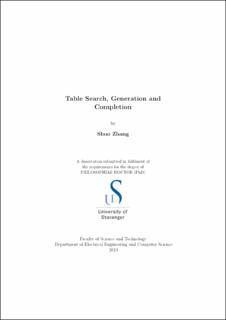| dc.contributor.advisor | Balog, Krisztian | |
| dc.contributor.author | Zhang, Shuo | |
| dc.date.accessioned | 2020-04-24T07:08:06Z | |
| dc.date.available | 2020-04-24T07:08:06Z | |
| dc.date.issued | 2019-10 | |
| dc.identifier.citation | Table Search, Generation and Completion by Shuo Zhang, Stavanger : University of Stavanger, 2020 (PhD thesis UiS, no. 478) | en_US |
| dc.identifier.isbn | 978-82-7644-873-3 | |
| dc.identifier.issn | 1890-1387 | |
| dc.identifier.uri | https://hdl.handle.net/11250/2652307 | |
| dc.description | PhD thesis in Information technology | en_US |
| dc.description.abstract | Tables are one of those “universal tools” that are practical and useful in many application scenarios. Tables can be used to collect and organize information from multiple sources and then turn that information into knowledge (and, ultimately, support decision-making) by performing various operations, like sorting, filtering, and joins. Because of this, a large number of tables exist already out there on the Web, which represent a vast and rich source of structured information that could be utilized.
The focus of the thesis is on developing methods for assisting the user in completing a complex task by providing intelligent assistance for working with tables. Specifically, our interest is in relational tables, which describe a set of entities along with their attributes.
Imagine the scenario that a user is working with a table, and has already entered some data in the table. Intelligent assistance can include providing recommendations for the empty table cells, searching for similar tables that can serve as a blueprint, or even generating automatically the entire a table that the user needs. The table-making task can thus be simplified into just a few button clicks. Motivated by the above scenario, we propose a set of novel tasks such as table search, table generation, and table completion. Table search is the task of returning a ranked list of tables in response to a query. Google, for instance, can now provide tables as direct answers to plenty of queries, especially when users are searching for a list of things. Figure 1.1 shows an example. Table generation is about automatically organizing entities and their attributes in a tabular format to facilitate a better overview. Table completion is concerned with the task of augmenting the input table with additional tabular data. Figure 1.2 illustrates a scenario that recommends row and column headings to populate the table with and automatically completes table values from verifiable sources. In this thesis, we propose methods and evaluation resources for addressing these tasks. | en_US |
| dc.language.iso | eng | en_US |
| dc.publisher | University of Stavanger, Norway | en_US |
| dc.relation.ispartofseries | PhD thesis UiS; | |
| dc.relation.ispartofseries | ;478 | |
| dc.rights | Copyright the author, all right reserved | |
| dc.rights | Navngivelse 4.0 Internasjonal | * |
| dc.subject | datateknologi | en_US |
| dc.subject | informasjonsteknologi | en_US |
| dc.title | Table Search, Generation and Completion | en_US |
| dc.type | Doctoral thesis | en_US |
| dc.rights.holder | (c) Shuo Zhang 2019 | en_US |
| dc.subject.nsi | VDP::Mathematics and natural science: 400::Information and communication science: 420 | en_US |
